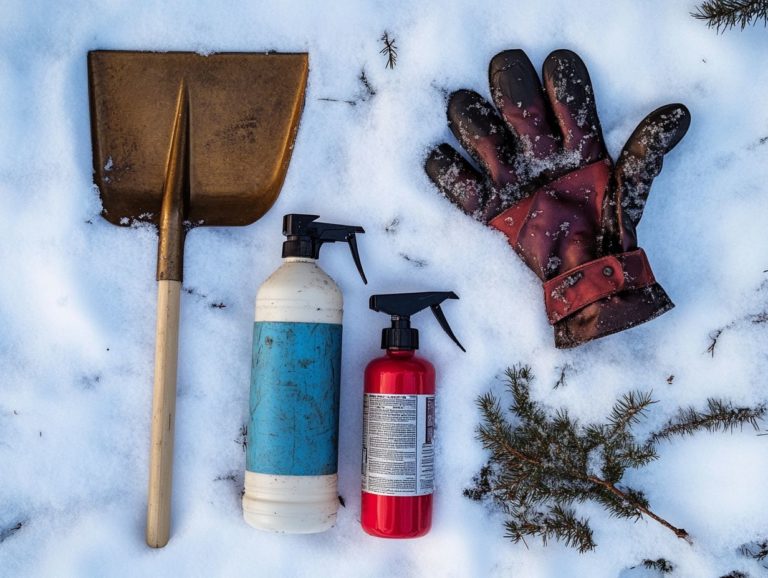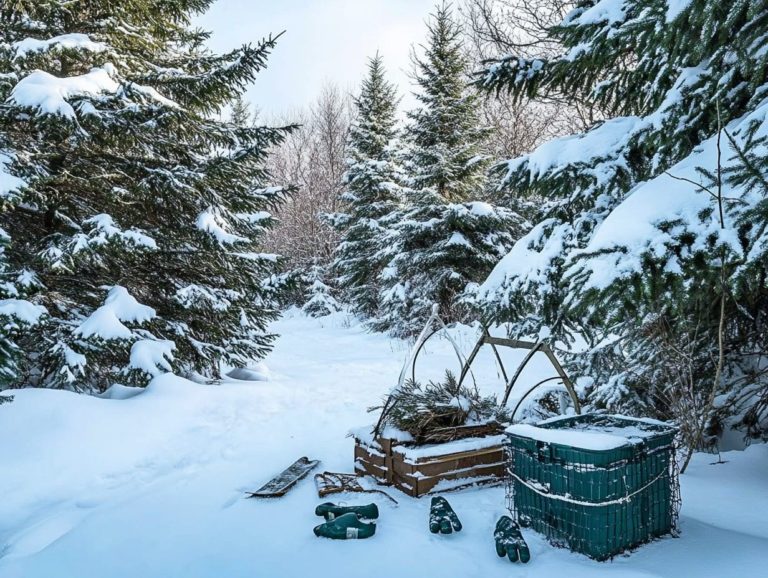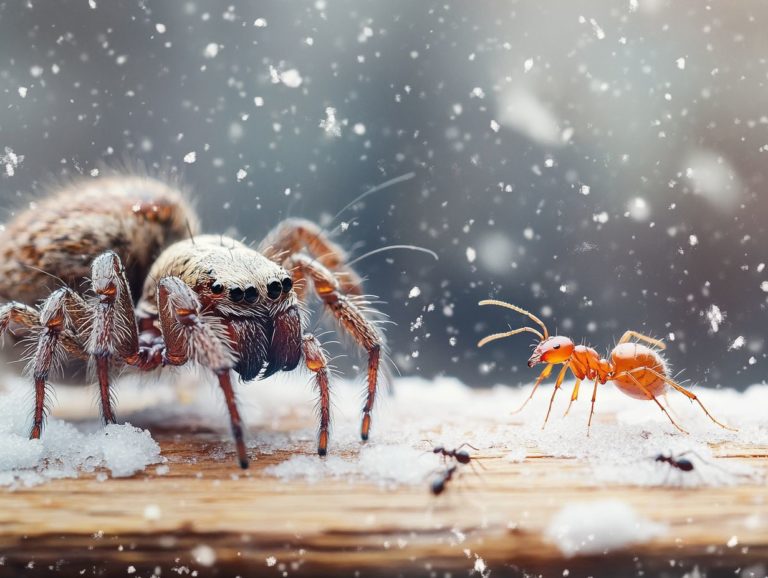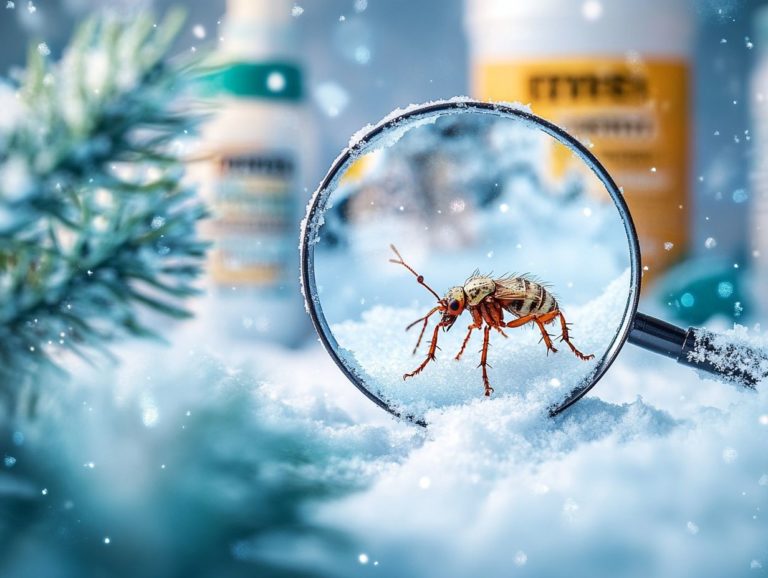Identifying Common Cold-Weather Garden Pests
As winter approaches, you might think your plants are off the hook when it comes to pests. However, cold-weather garden invaders can still cause significant trouble for your cherished greens.
This guide is designed to help you identify these tenacious pests, understand their traits, and spot the signs of an infestation.
Delve into effective pest control strategies, both organic and chemical-free, and discover valuable tips to keep your garden thriving even in the chill. Equip yourself with the knowledge to safeguard your hard work and ensure a flourishing garden throughout the season!
Contents
- Key Takeaways:
- What are Cold-Weather Garden Pests?
- Identifying Common Pests in Cold Weather
- Preventing and Managing Pests in Cold Weather
- Effective Pest Control Methods
- Organic and Natural Pest Control Options
- Chemical-Free Alternatives
- Signs of Pest Infestation in Cold Weather
- Protecting Your Garden from Cold-Weather Pests
- Frequently Asked Questions
- What are some common cold-weather garden pests that can damage plants?
- How can I identify aphids in my garden during the colder months?
- What are the signs of caterpillar infestation in cold weather gardens?
- How do I know if snails and slugs are causing damage to my cold-weather plants?
- Are whiteflies a common pest in cold weather gardens?
- How can I prevent and manage these common cold-weather garden pests?
Key Takeaways:
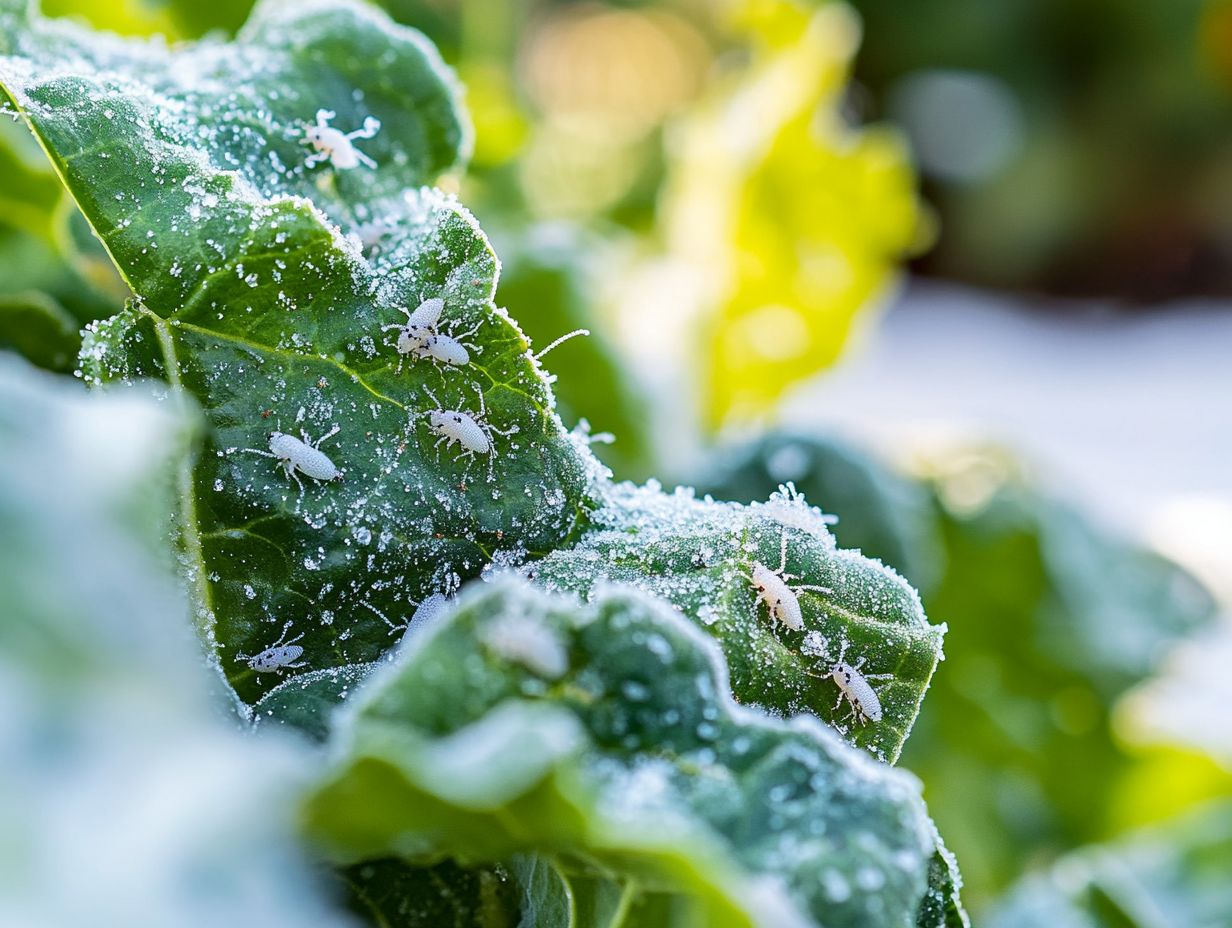
- Identify common pests in cold weather by knowing their characteristics and behavior.
- Prevent and manage pests using effective control methods and exploring organic and natural options.
- Protect your garden from cold-weather pests by keeping an eye out for signs of infestation and implementing pest-free gardening practices.
What are Cold-Weather Garden Pests?
Cold-weather garden pests present a formidable challenge for you as a gardener, impacting a variety of vegetable crops. It’s important to be aware of the top 5 insects to watch for in cold-climate gardens.
These unwelcome invaders think Japanese beetles, Cabbage moths, Cucumber beetles, and Colorado potato beetles can significantly obstruct plant growth and reduce yields.
Grasping their behaviors and characteristics is vital for mastering effective pest management. This ensures your garden flourishes. As temperatures drop, it’s crucial to spot and tackle these pests quickly to protect your garden!
Identifying Common Pests in Cold Weather
Identifying common pests during the colder months is essential for effective pest management. Utilizing organic pest solutions for cold climates can help address these issues, as various pests exhibit distinct behaviors in this season.
You may find yourself dealing with pests such as aphids, hornworms, and squash bugs, which can surprisingly flourish despite the dropping temperatures.
Accurately recognizing these invaders allows you to select the appropriate Integrated Pest Management (IPM) strategies. Integrated Pest Management (IPM) is a sustainable approach to managing pests that combines different strategies to keep your garden healthy.
Types of Pests and Their Characteristics
As cold weather sets in, various types of pests may invade your garden. To effectively manage them, it’s important to understand common pests in cold-climate gardening, as each has unique characteristics that will affect your approach.
These unwelcome visitors not only compete for precious resources but also carry diseases that can jeopardize the health of your vegetable crops.
For instance, aphids are small but can quickly multiply. They suck the sap from your plants, making them weak and vulnerable. On the other hand, spider mites thrive in dry conditions, extracting nutrients and causing unsightly leaf discoloration.
To tackle these adversaries, you ll often turn to Integrated Pest Management. This approach emphasizes sustainable and environmentally friendly techniques tailored to the specific behaviors of each pest.
By gaining insight into their life cycles and habits, you can implement targeted pest management solutions that minimize damage and encourage healthy growth. This ultimately paves the way for a more bountiful harvest.
Preventing and Managing Pests in Cold Weather
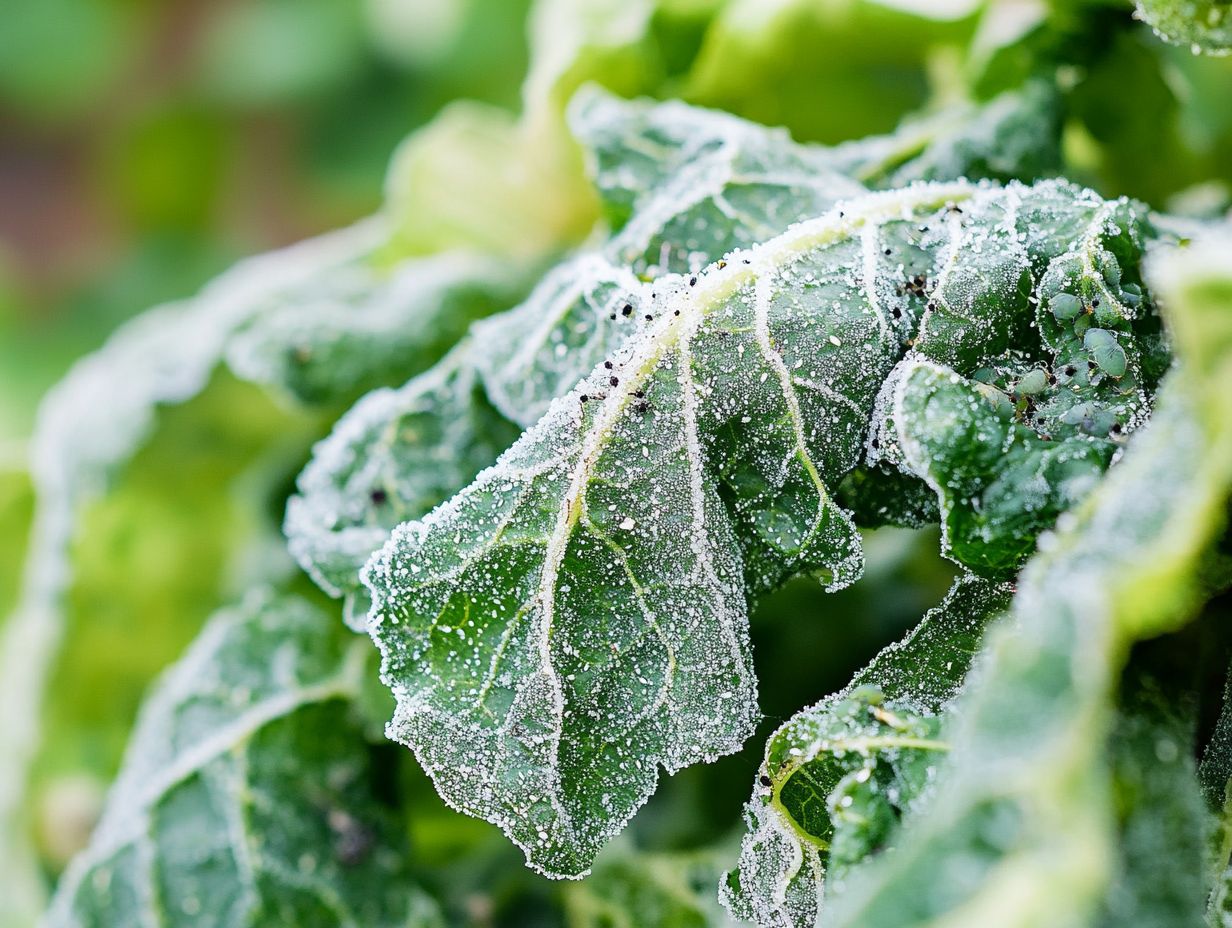
Preventing and managing pests during cold weather demands a proactive approach that marries an understanding of pest behavior with the implementation of effective strategies.
By integrating principles from Integrated Pest Management (IPM), you can significantly reduce pest populations without putting beneficial insects at risk.
Employing techniques such as crop rotation, physical barriers, and organic pest management allows you to cultivate an environment that deters nuisances like aphids and hornworms. This fosters the growth of healthy vegetable crops.
Start monitoring your garden today to keep those pests at bay!
Effective Pest Control Methods
Implementing effective pest control methods is crucial for safeguarding your garden against cold-weather pests. This ensures healthy growth and abundant harvests. Organic pesticides, such as insecticidal soap and pyrethrins, serve as valuable allies in your battle against pests like Colorado potato beetles and stink bugs. These methods not only target harmful intruders but also minimize the impact on beneficial species, fostering a balanced ecosystem in your garden.
Consider options like neem oil, which disrupts the lifecycle of pests and effectively combats aphids and spider mites. Diatomaceous earth, on the other hand, creates a physical barrier that can deter crawling insects with ease.
Embrace companion planting as a natural pest-repelling tactic. For example, marigolds are renowned for their ability to deter nematodes.
Regularly introducing beneficial insects like ladybugs and lacewings can help keep pest populations in check while enhancing the overall health of your garden. Each of these strategies addresses specific pest issues and aligns with sustainable gardening practices, helping your plants grow well.
Organic and Natural Pest Control Options
Organic and natural pest control options present sustainable solutions for managing cold-weather pests in your garden. They underscore the significance of nurturing a healthy ecosystem.
By utilizing Bacillus thuringiensis, a naturally occurring bacterium, you can effectively target troublesome insects like hornworms while safeguarding beneficial species. Likewise, spinosad provides an organic approach to combat pests such as leaf miners and flea beetles. This allows you to lessen your dependence on chemical pesticides like neonicotinoids, a group of chemical pesticides, and embrace environmentally friendly practices.
Chemical-Free Alternatives
Chemical-free pest control options are exciting for gardeners who want a healthy ecosystem while tackling cold-weather pests. By utilizing beneficial insects like ladybugs, you can effectively diminish aphid populations without harmful side effects. Incorporating organic fertilizers promotes plant health and enhances their resilience to pest infestations.
Introducing predatory mites or nematodes establishes a natural balance by targeting specific harmful insects. Practices like companion planting can deter pests while attracting beneficial species, enriching biodiversity. This approach bolsters ecological health and diminishes reliance on synthetic chemicals that can adversely affect soil quality and local wildlife.
For optimal results, explore essential oil sprays or homemade remedies featuring garlic or cayenne pepper to keep unwanted visitors at bay. This way, you cultivate a vibrant landscape that is both productive and safe for the helpful creatures that share your garden.
Signs of Pest Infestation in Cold Weather
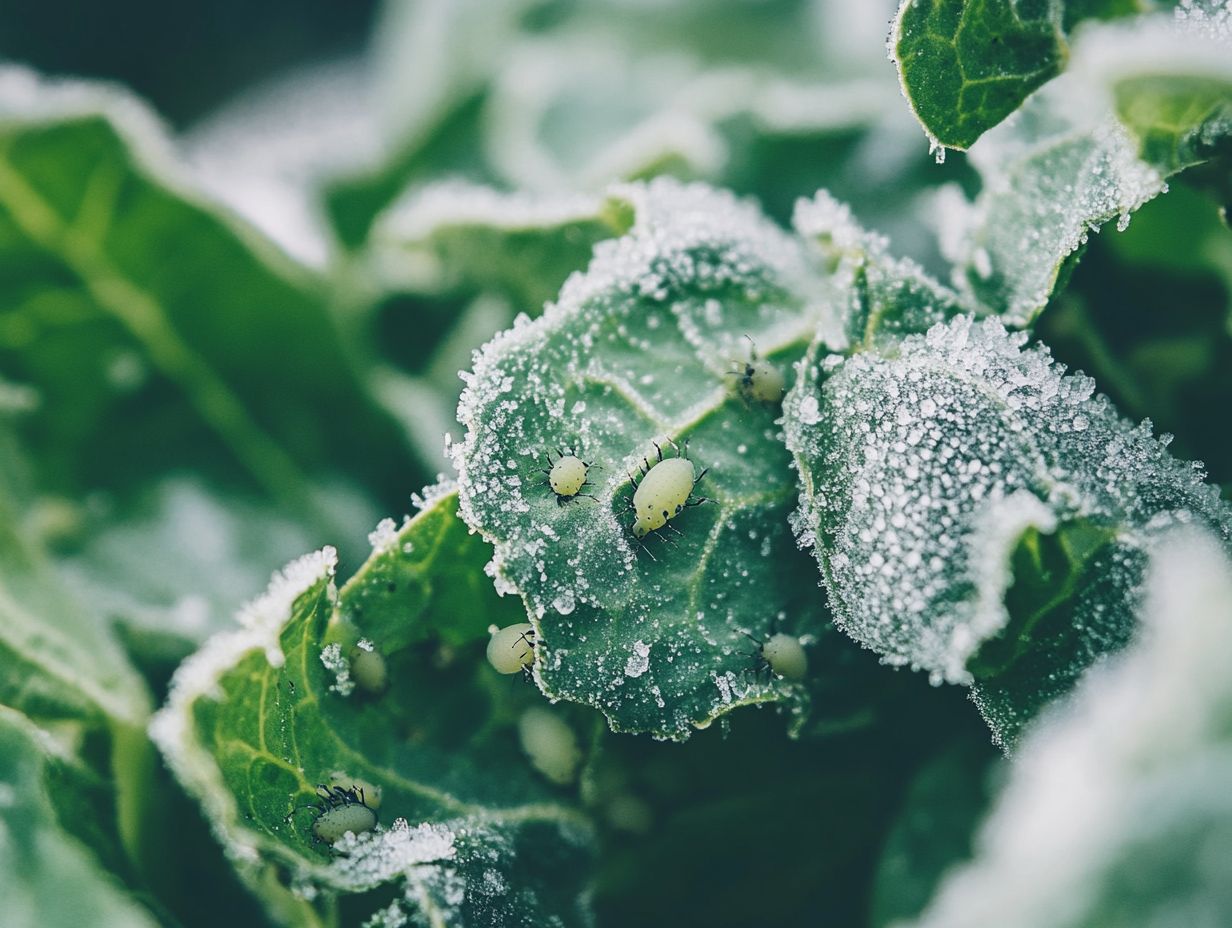
Recognizing the signs of pest infestation during cold weather is crucial for ensuring your garden’s health, especially with notorious pests like stink bugs making appearances. Symptoms such as discolored leaves, unexpected holes in the foliage, and stunted growth serve as clear indicators of potential pest damage.
Pay attention to these signs so you can swiftly tackle any infestations that arise. Employing strategies like Integrated Pest Management will help you maintain the robustness and productivity of your vegetable crops, allowing you to enjoy a flourishing garden season after season.
How to Spot and Address Infestations
Spotting and addressing infestations promptly is essential for maintaining the health of your garden, particularly during colder months when pests may be less visible. By regularly monitoring your vegetable crops and looking for signs of damage or pest activity, you can identify potential issues early on.
Using pest control methods, such as organic pesticides, allows you to tackle infestations before they spiral out of control.
You should establish a routine inspection schedule, examining your plants at least once a week. Regularly check for Japanese beetles or other unwanted pests that can emerge during these months. Pay close attention to the undersides of leaves, where pests like aphids or spider mites tend to hide.
Utilizing sticky traps can also help you capture flying pests early, like flea beetles, giving you a visual tool to track their populations. Introducing natural predators, like ladybugs, can further assist in controlling specific pest species.
Emphasizing Integrated Pest Management (IPM) which means combining different methods to manage pests effectively enables you to blend these methods with cultural practices, such as crop rotation and maintaining soil health. This approach reduces the reliance on chemical interventions while fostering a balanced ecosystem in your garden especially valuable for sustaining a healthy ecosystem and reducing pest pressures.
Protecting Your Garden from Cold-Weather Pests
Protecting your garden from cold-weather pests requires a strategic blend of proactive measures and timely interventions to safeguard your prized vegetable crops.
By adopting techniques such as crop rotation, employing organic pesticides, and fostering beneficial insects, you can cultivate a resilient environment that effectively deters pests like cucumber beetles and stink bugs.
Taking these thoughtful steps will ensure that your garden flourishes even during the colder months.
Tips for Maintaining a Pest-Free Garden
Maintaining a pest-free garden demands your consistent effort and the implementation of effective pest management practices throughout the growing season. By embracing organic methods like companion planting, keeping a close eye on your plants, and introducing beneficial insects, you ll dramatically cut down on pesky pests while promoting vibrant plant growth.
Educating yourself about common cold-weather pests and their behaviors, such as understanding pest behavior in cold weather, gives you the power to be both prepared and proactive in your gardening endeavors.
By staying informed about various natural deterrents and understanding the life cycles of harmful invaders, you can implement targeted strategies that respect the ecosystem. For example, using neem oil as a natural pesticide and regularly inspecting your plants for early signs of infestation can be crucial in safeguarding your garden.
Regularly rotating your crops and using organic mulch not only enhances soil health but also disrupts pest life cycles, making it more challenging for them to establish a foothold.
Ultimately, as a well-informed gardener, you ll reap the rewards of a flourishing garden while adopting an environmentally sustainable approach.
Frequently Asked Questions
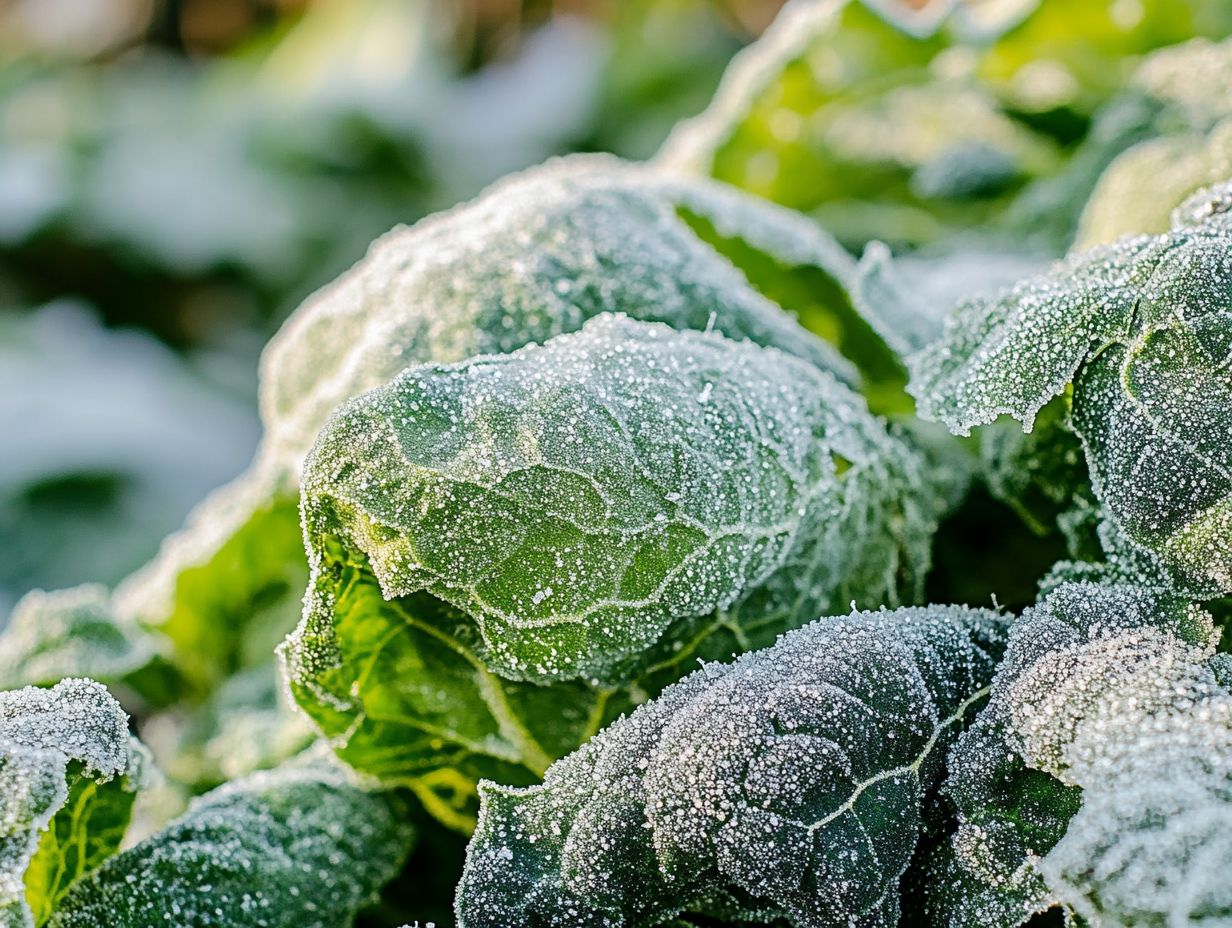
What are some common cold-weather garden pests that can damage plants?
Some common pests that thrive in cold weather are aphids, caterpillars, snails, slugs, and whiteflies, but it’s equally important to be aware of identifying common winter plant diseases that can affect your garden.
How can I identify aphids in my garden during the colder months?
Aphids are small, pear-shaped insects that can be green, black, brown, or red in color. They often cluster on the undersides of leaves and can cause leaves to curl or become distorted.
What are the signs of caterpillar infestation in cold weather gardens?
Caterpillars can be identified by their chewing damage on leaves, stems, and fruit. They may also leave behind visible droppings on plants.
How do I know if snails and slugs are causing damage to my cold-weather plants?
Snails and slugs leave behind a silvery trail of slime on plants and can cause holes in leaves and flowers. They are most active at night and can be found hiding in damp areas during the day.
Are whiteflies a common pest in cold weather gardens?
Yes, whiteflies can thrive in colder months. They can survive in temperatures as low as 50 F. You can identify them by their small, white, moth-like appearance. These pests can cause leaves to wilt and turn yellow.
How can I prevent and manage these common cold-weather garden pests?
Check your plants regularly to catch whiteflies early. If you see any, act fast to remove them! You can also use natural solutions like neem oil or diatomaceous earth to keep pests away. In severe cases, use pesticides but follow the instructions carefully.

